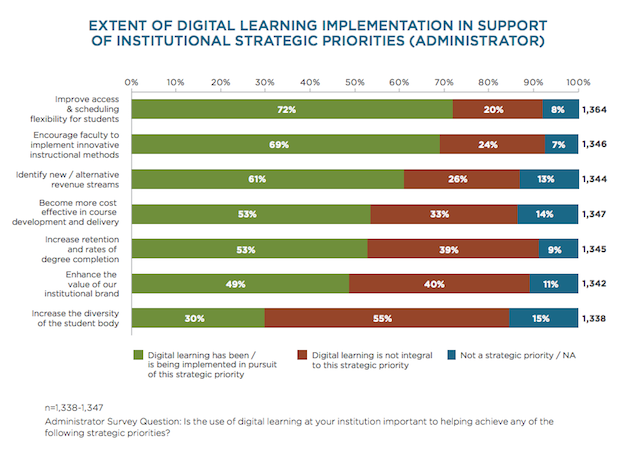Report: Faculty Support Lacking for Wide Adoption of Digital Learning
- By Dian Schaffhauser
- 06/19/17
Most colleges and universities are thinking and acting strategically regarding their digital learning initiatives. Most cover digital learning in their school's strategic plan, and a large number have made it a core aspect of their plans. Yet, execution is uneven and digital learning hasn't come close to meeting administrator or faculty expectations.
That summary comes out ofa new report produced by Tyton Partners in collaboration with the Babson Survey Research Group. A similar subject was undertaken in 2014 when Tyton interviewed more than 2,700 postsecondary faculty and administrators on their use and perceptions of digital courseware. The latest report updates that research and examines findings from two fall 2016 surveys of a national sample of 3,500 postsecondary respondents.

Researchers asked survey participants if the use of digital learning at their institution served any of the institutional goals listed in the infographic above. Image: Tyton Partners.
The gap between strategic hope and institutional outcome is most evident in the goal of identifying new and alternative revenue streams. While 61 percent of respondents reported that this was a strategic priority, only 38 percent reported that progress was happening in at or above expectations. Fifty-three percent of administrators reported that they anticipated digital learning to help their schools become more cost effective in course development and delivery; only 38 percent said that was happening to the extent hoped for.
The biggest motivator for expanding digital learning on campus was to improve access and scheduling flexibility for students. There, the disappointment wasn't quite as extensive; 65 percent said goals were being met.
These gaps and others "suggest a disconnect, the report stated, "between the impacts that many administrators perceive and the reality of how digital learning is changing the market." Open-ended responses suggested that expectations for the impact of digital learning were "set too high" or weren't being "measured or communicated well." Another common refrain: There's inadequate institutional support.
While most administrators told researchers that "faculty are crucial to the success of digital learning initiatives — serving as both a bolster and a barrier to implementation success," the resources for supporting faculty to implement digital learning are insufficient. Just a quarter of respondents said faculty professional development was implemented "effectively and at scale." Thirty-five percent said implementation was in progress. And a third (33 percent) reported that faculty professional development was "incomplete, inconsistent, informal and/or optional."
Another barrier to success is the decentralized nature of decision-making on campus. Implementing digital learning "at scale," the report asserted, "requires engagement with several decision-makers," which slows adoption of new teaching and learning technologies and increases its price tag.
A third inhibitor to large-scale adoption is low satisfaction with courseware. Peer recommendations are the way most faculty discover promising new products, yet these users are also reticent to recommend what they like; just 24 percent of faculty and 12 percent of administrators said they'd be likely to do so.
The report offered recommendations for improving and expanding digital learning adoption. Among the guidance:
- Get realistic. While the data suggested that digital learning could improve scheduling flexibility and access, among other benefits, schools need to identify which goals are most important and "clearly articulate how and to what extent its digital learning programs are expected to help."
- Measure impact and broadcast it. Forget about small pilots; go for a scale that will demonstrate impact and then share the findings internally and with other institutions.
- Use buying power to influence the market. Connect faculty with vendors for "education, product discovery and feedback." Insist on accessibility within products, strong integration features and user friendliness.
- Prepare faculty for success. Make sure there are sufficient resources and incentives to help faculty "buy into the strategy" and follow through on implementation.
The complete report, "Time for Class 2017," is available for registration on the Tyton Partners site.
About the Author
Dian Schaffhauser is a former senior contributing editor for 1105 Media's education publications THE Journal, Campus Technology and Spaces4Learning.